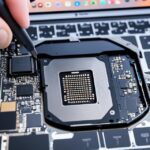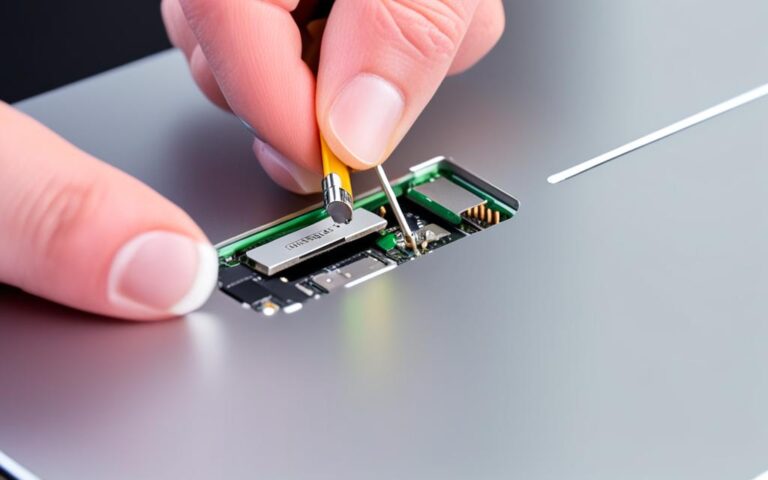Addressing MacBook Pro Fan Noise
One common issue that MacBook Pro users encounter is excessive fan noise. While fans are necessary for cooling the device, they can become loud and disruptive in some cases. In this guide, we will explore the potential reasons for loud fan noise in a MacBook Pro and provide effective solutions to address this problem. By implementing these tips, you can enhance the performance of your MacBook Pro while ensuring a quieter experience.
Why are MacBook Pro fans loud?
Most Macs, including the MacBook Pro, have cooling fans that help dissipate heat generated by the processors and other electronic components. Under normal circumstances, these fans operate quietly in the background. However, when engaging in demanding tasks such as video editing or running resource-intensive applications, the fans may spin faster, resulting in increased noise. Excessive fan noise can also occur due to software issues or blocked vents.
This section will delve into the potential reasons for loud fan noise in a MacBook Pro and provide tips to fix the problem.
Potential Reasons for Loud Fan Noise
There are several factors that can contribute to excessive fan noise in a MacBook Pro:
- Demands of resource-intensive tasks: When your MacBook Pro is under heavy load, such as during video editing or running demanding applications, the processors generate more heat. In response, the fans spin faster to dissipate the heat, resulting in louder noise levels.
- Software issues: Sometimes, software-related problems can cause the fans to run at higher speeds than necessary. This can be triggered by background processes, unnecessary system tasks, or compatibility issues with certain applications.
- Blocked vents: Dust and debris can accumulate in the vents of your MacBook Pro, limiting proper airflow. When the vents are blocked, the fans have to work harder to cool the system, leading to increased noise.
Potential Fixes for Loud Fan Noise
To address excessive fan noise in your MacBook Pro, consider these potential solutions:
- Close resource-intensive applications: If you’re not actively using resource-heavy applications, quitting them can help reduce fan speed and noise levels. Check the Activity Monitor to identify and close any processes that are consuming a significant amount of CPU power.
- Clean the vents: Regularly clean the vents of your MacBook Pro to remove dust and debris. This can be done using a soft brush or compressed air.
- Optimize system performance: Update your MacBook Pro’s software to the latest version to ensure optimal performance and compatibility. Additionally, consider using optimization tools to clean up unnecessary files and processes that may contribute to increased fan noise.
“Excessive fan noise can be frustrating, but by understanding the underlying reasons and implementing the appropriate fixes, you can restore a quieter operation to your MacBook Pro.”
By taking these steps, you can effectively reduce fan noise and enhance the overall performance of your MacBook Pro.
Tips to reduce fan noise in a MacBook Pro
If you’re experiencing excessive fan noise on your MacBook Pro, there are several solutions you can implement to reduce the noise and improve the overall performance of your device. By following these tips, you can ensure a quieter and more efficient computing experience.
- Ensure Unobstructed Airflow: The first step is to check that the vents on your MacBook Pro are not blocked. Blocked vents can impede proper airflow, causing the fans to work harder and produce more noise. If you notice any dust or debris in the vents, clean them using a brush to remove any obstructions.
- Monitor CPU Usage: High CPU usage can put a strain on your processor, leading to increased fan speed and noise. Use the Activity Monitor to identify processes that consume excessive CPU resources and stop or close them if possible. This can help alleviate the strain on the processor and reduce fan noise.
- Control Ambient Temperature: The ambient temperature in the room where your MacBook Pro is used can impact fan speed. Excessive heat can cause the fans to spin faster and louder. To mitigate this, consider lowering the ambient temperature by using air conditioning or ensuring proper ventilation in the room.
Implementing these solutions can significantly minimize fan noise in your MacBook Pro and enhance its overall performance. Ensure that the vents are unblocked, monitor CPU usage, and control the ambient temperature in your surroundings. By taking these steps, you can enjoy a quieter and more efficient MacBook Pro experience.
Checking for hardware issues and external factors
In some cases, hardware issues or external factors can contribute to excessive fan noise in a MacBook Pro. Faulty components or malfunctioning heat sensors can cause the fans to spin faster and louder. To determine if there are any hardware problems, you can run Apple Diagnostics, a built-in diagnostic tool provided by macOS. This tool can identify and provide information on hardware issues that may be affecting fan performance.
Additionally, resetting the System Management Controller (SMC) can help resolve some fan-related issues. The SMC is responsible for managing various hardware components, including the cooling system. By resetting it, you can potentially fix any glitches or irregularities that may be causing the excessive fan noise.
Furthermore, it is crucial to check for any malware or malicious software that may be affecting your MacBook Pro’s fan behavior. Malware can disrupt system processes and cause the fans to work harder than necessary. Performing regular scans with reputable antivirus software can help identify and eliminate any malware that may be compromising your device’s performance.
To summarize, when faced with excessive fan noise in your MacBook Pro, it is essential to consider both hardware and external factors. Running Apple Diagnostics, resetting the SMC, and checking for malware can help diagnose and resolve any underlying issues that may be contributing to the fan noise problem.
| Steps to Check for Hardware Issues and External Factors |
|---|
| 1. Run Apple Diagnostics to identify hardware problems |
| 2. Reset the System Management Controller (SMC) to resolve fan-related issues |
| 3. Perform regular scans for malware and eliminate any malicious software |
Quote:
“By addressing these hardware and software factors, you can effectively reduce fan noise and ensure optimal performance.” – MacBook Pro Solutions
Optimizing your MacBook Pro for quieter operation
To ensure quieter operation of your MacBook Pro, it is essential to implement certain optimization strategies. By following these recommendations, you can minimize fan noise and enhance the overall performance of your device. Here are some key steps to optimize your MacBook Pro:
1. Keep your software up to date
Regularly updating your MacBook Pro’s software is crucial for improving efficiency and resolving any potential performance issues. Apple releases system updates that address bugs and enhance the overall functionality of your device. To update your software, go to the Apple menu, select “System Preferences,” and click on “Software Update.”
2. Ensure proper ventilation
Proper ventilation is essential for reducing fan noise. Ensure that the ventilation vents on your MacBook Pro are not blocked or obstructed. Dust and debris can accumulate over time, hindering airflow and causing the fans to work harder. Consider using a laptop stand or cooling pad to improve air circulation around your device.
3. Quit heavy apps and monitor CPU usage
Resource-intensive applications can put a strain on your MacBook Pro’s processor, causing the fans to spin faster and generate more noise. Quitting unnecessary or heavy apps can help alleviate this strain. Additionally, you can monitor the CPU usage using the built-in Activity Monitor tool. Identify and close any processes that consume excessive CPU resources, thereby reducing fan noise.
4. Run hardware diagnostics
Running hardware diagnostics can help identify any underlying issues that may be contributing to fan noise. MacBooks come equipped with a built-in tool called Apple Diagnostics. Simply restart your MacBook Pro and hold down the “D” key during startup. This will launch the diagnostic tool, which can provide insights into any potential hardware problems affecting your MacBook Pro’s performance.
5. Utilize optimization tools
There are various optimization tools available that can help improve the performance of your MacBook Pro and reduce fan noise. Tools like iStat Menus and CleanMyMac X provide comprehensive system monitoring, optimization, and maintenance features. They can help identify and fix underlying performance issues, resulting in quieter operation and enhanced overall performance.
| Optimization Tools | Features |
|---|---|
| iStat Menus | Real-time monitoring of CPU, RAM, and network usage; customizable notifications; temperature and fan control; disk health monitoring |
| CleanMyMac X | Disk cleanup and optimization; malware removal; privacy protection; app uninstallation; performance monitoring and optimization |
By implementing these optimization strategies, you can ensure quieter operation of your MacBook Pro and enjoy an enhanced computing experience. Remember to keep your software up to date, maintain proper ventilation, quit unnecessary apps, run hardware diagnostics, and utilize optimization tools. These steps will not only minimize fan noise but also optimize the overall performance and longevity of your MacBook Pro.
Conclusion
Excessive fan noise in a MacBook Pro can be disruptive and indicate potential issues with cooling or system performance. By following the tips and solutions outlined in this guide, you can effectively address fan noise and optimize the performance of your MacBook Pro. From ensuring proper ventilation to monitoring CPU usage and running hardware diagnostics, these steps will help create a quieter and more efficient computing experience. Implementing these strategies will allow you to enjoy a MacBook Pro that operates at peak performance without excessive fan noise.












